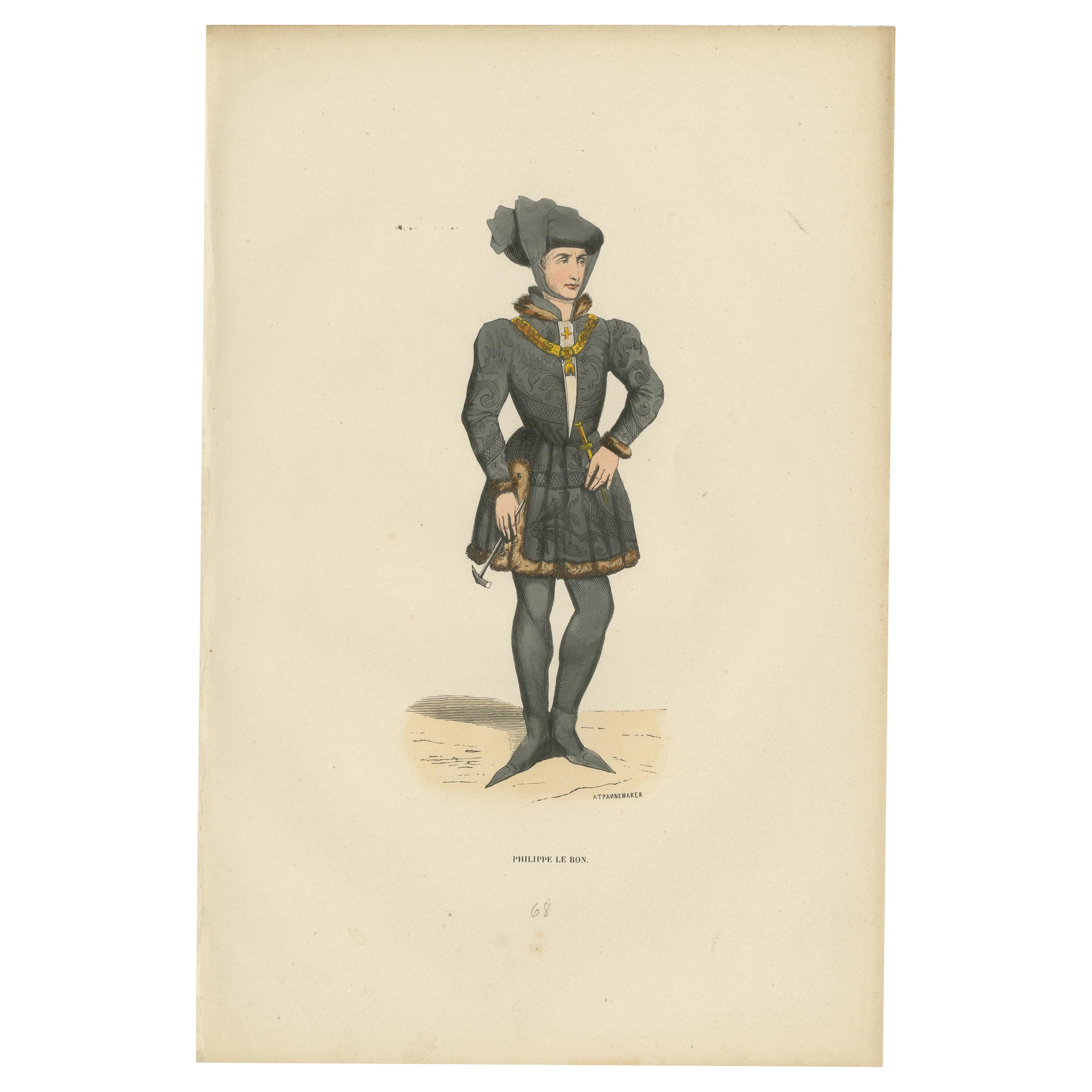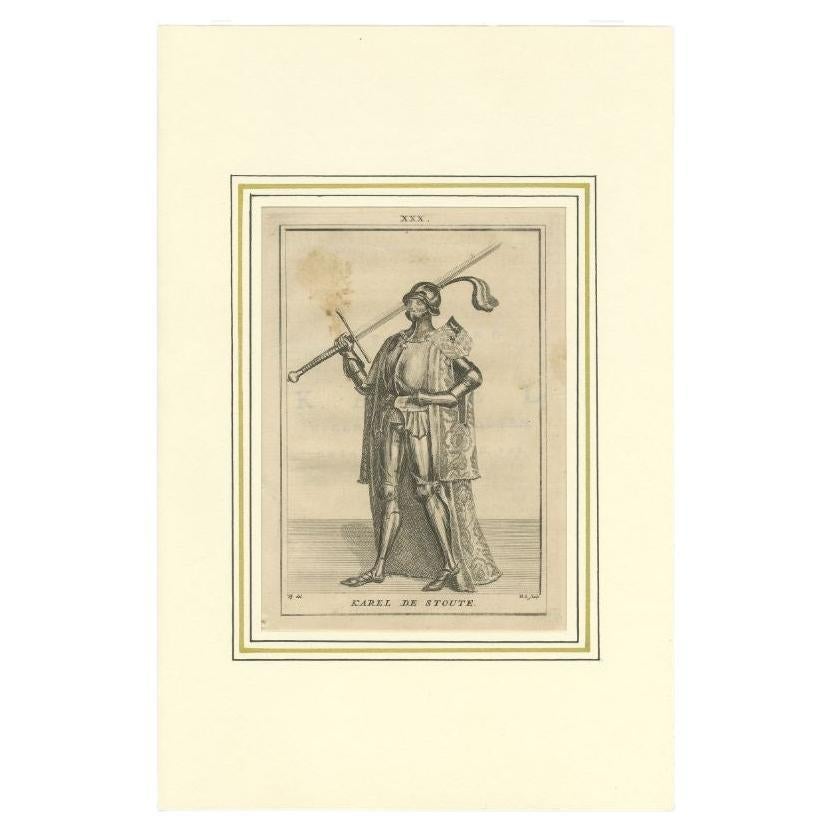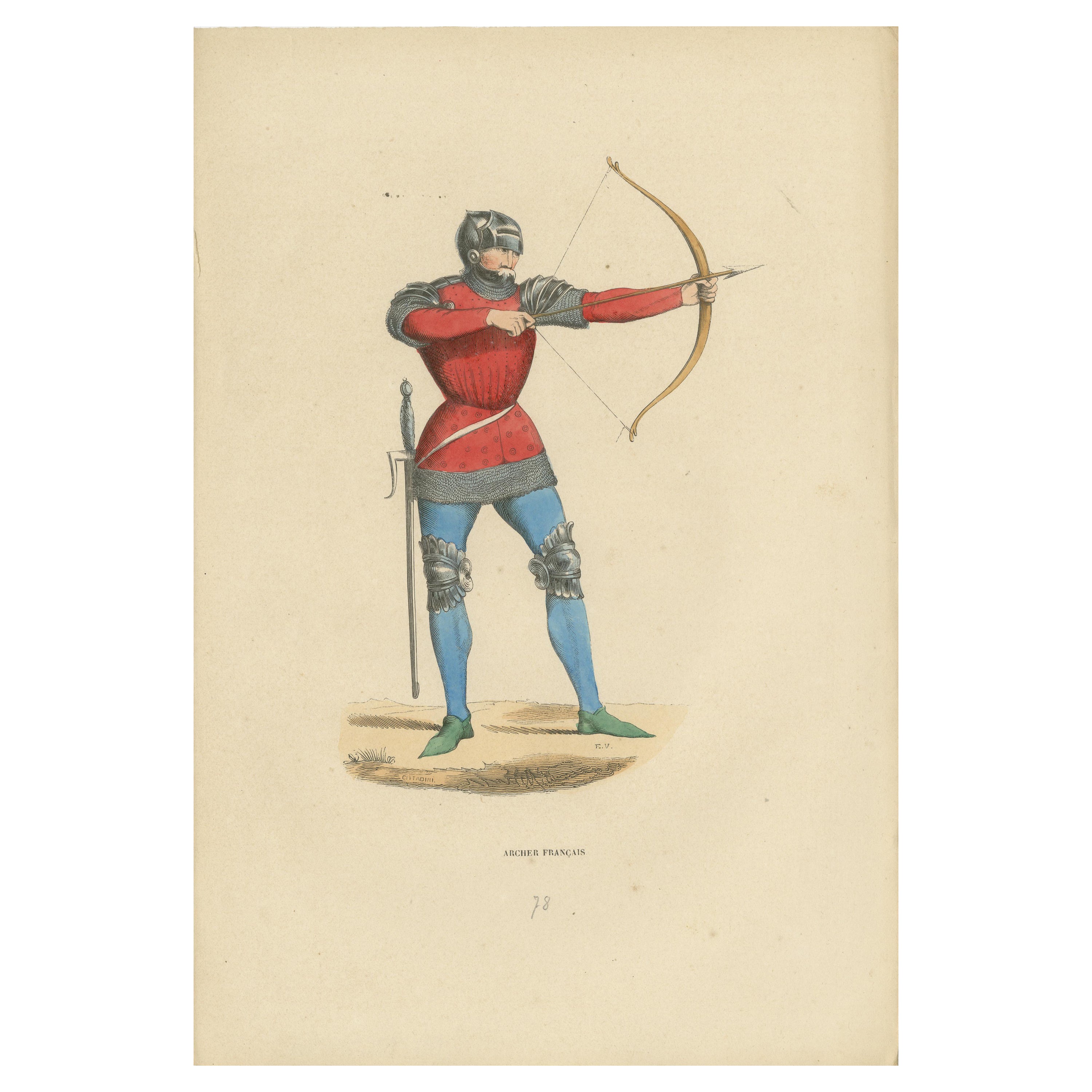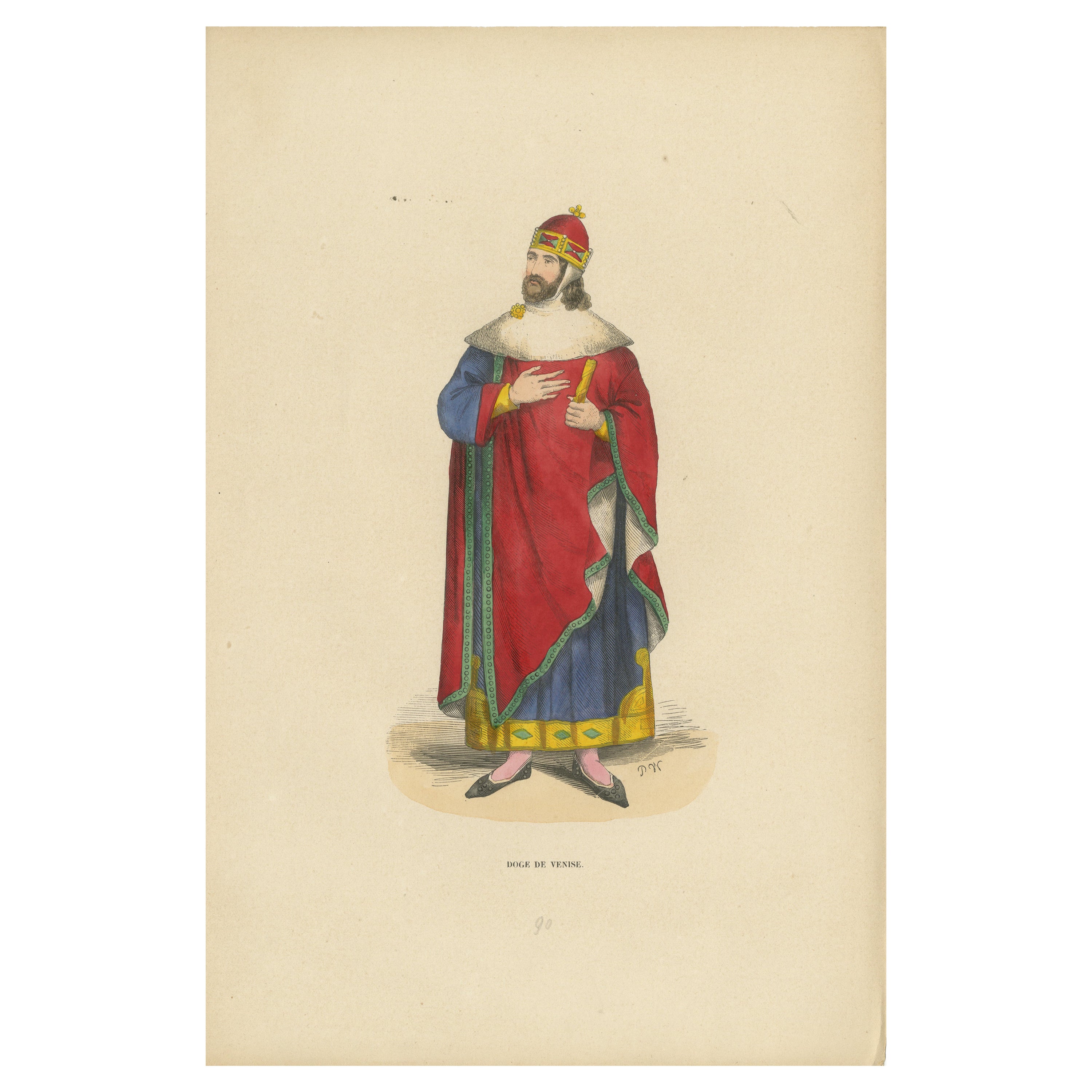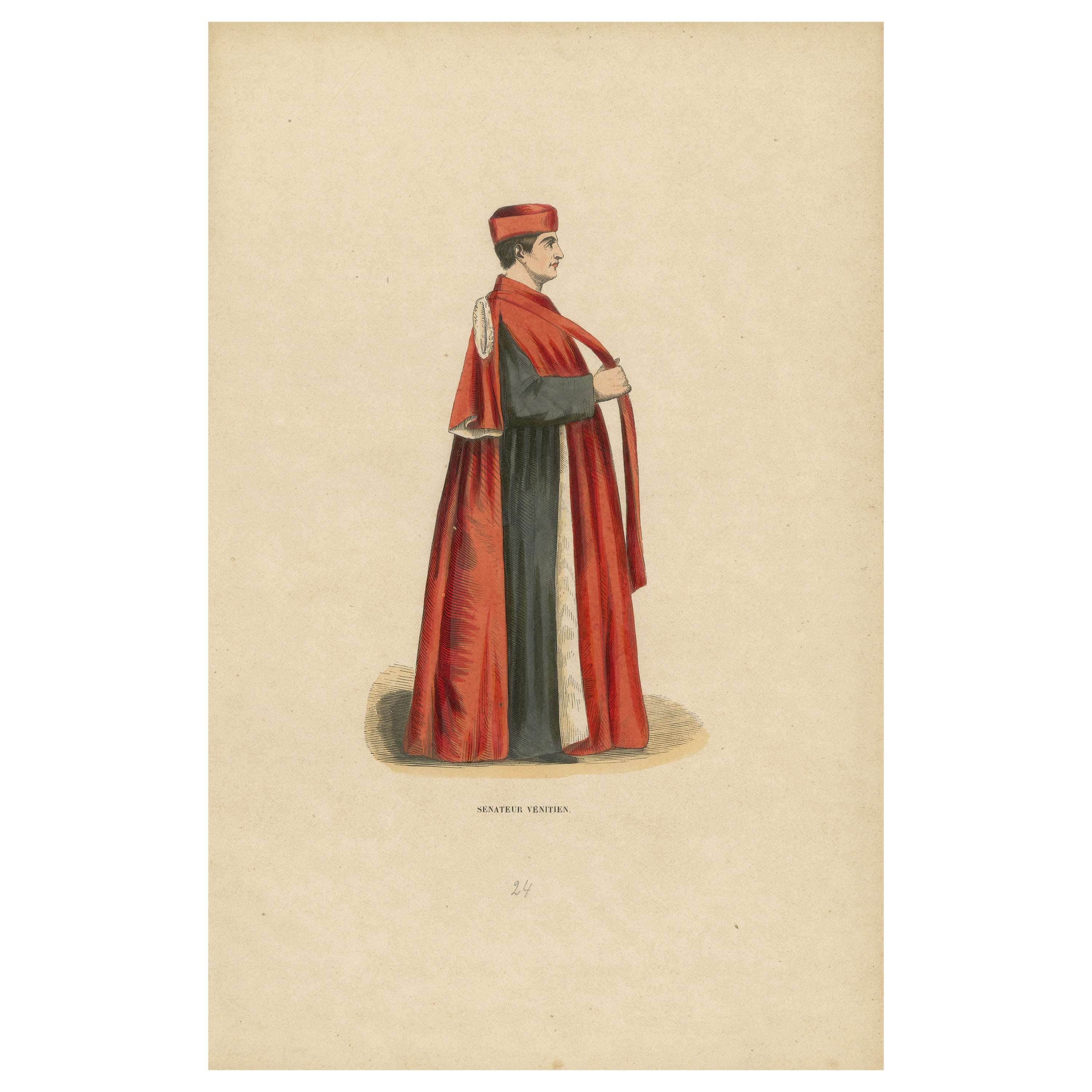Items Similar to Old Engraving of Philippe le Hardi: The Bold Duke of Burgundy in Council, 1847
Want more images or videos?
Request additional images or videos from the seller
1 of 7
Old Engraving of Philippe le Hardi: The Bold Duke of Burgundy in Council, 1847
About the Item
Title: "Philippe le Hardi: The Bold Duke in Council"
Description: This print captures Philippe le Hardi, also known as Philip the Bold, Duke of Burgundy, seated in a posture of consultation or leadership. He is depicted in the midst of governance or decision-making, a role befitting his historical reputation as a founder of the Burgundian state.
The Duke is attired in a blue doublet emblazoned with golden fleur-de-lis, a symbol of his connection to the French royal lineage. The doublet is tailored to his form, suggesting the refined tastes of Burgundian court fashion. The edges of the doublet feature a decorative border, adding to the noble appearance.
He wears a red and white striped chaperon, a stylish head covering for men of the period, which features a twisted scarf around the crown, indicative of his high social status. The chaperon complements his doublet with its own hint of golden embellishment.
His hose are striped in yellow and black, providing a striking contrast to the blue of his doublet. This choice of colors may reflect the heraldic colors of his house. The red footrest under his feet is a rich detail that adds a note of luxury and comfort.
Philippe's right hand is slightly extended as if in mid-gesture, perhaps making a point or issuing an order, while his left hand rests on his knee, grounding him in his authoritative position. His expression is one of contemplative leadership, and his eyes appear to be focused on an unseen interlocutor or thought.
This portrayal of Philippe le Hardi encapsulates the image of a duke actively involved in the arts of rulership and diplomacy that characterized the governance style of the powerful Burgundian dukes during the late Middle Ages.
The colors have a nice glow over them. Historically, egg whites, known as glair, and sometimes egg yolk were indeed used in illumination and painting, particularly in manuscripts, to give colors a brighter appearance and to add a sheen or gloss to the work. This technique was quite common during the Middle Ages and into the Renaissance.
Egg whites can be applied as a varnish over pigments to enhance their brightness and to protect the colors. This application could make the colors appear more vivid and also add a slight glossy sheen to the surface of the image.
Egg yolk, on the other hand, was commonly used as a binding agent in paint. It forms the basis of tempera paint, a medium that was widely used before the advent of oil painting. Egg yolk helps to create a durable and long-lasting color that adheres well to various surfaces.
In the context of the print from 1847, it's less likely that egg whites or yolks were used directly on the print, as by that time, commercial printing processes would have been more advanced and less reliant on such manual methods. However, if this print is a representation of an earlier style or is meant to mimic the appearance of hand-painted manuscripts, the original artists might have employed techniques or materials that gave a similar effect to those achieved with egg-based binders and varnishes.
- Dimensions:Height: 10.63 in (27 cm)Width: 7.09 in (18 cm)Depth: 0 in (0.02 mm)
- Materials and Techniques:
- Period:
- Date of Manufacture:1847
- Condition:Good. Overal light toning and light soiling but the image itself clean and hand-colored almost 200 years ago and still in expliciet colors. Aged paper with typically warm, yellowish-brown hue, mostly around the edges. Study the image carefully.
- Seller Location:Langweer, NL
- Reference Number:
About the Seller
5.0
Platinum Seller
These expertly vetted sellers are 1stDibs' most experienced sellers and are rated highest by our customers.
Established in 2009
1stDibs seller since 2017
1,947 sales on 1stDibs
Typical response time: <1 hour
- ShippingRetrieving quote...Ships From: Langweer, Netherlands
- Return PolicyA return for this item may be initiated within 14 days of delivery.
More From This SellerView All
- Philippe le Bon or The Good, Duke of Burgundy: The Duke's Prestige, 1847Located in Langweer, NLTitle: "Philippe le Bon: The Duke's Prestige" Description: The print showcases Philippe le Bon, also known as Philip the Good, Duke of Burgundy, standing in a dignified pose that conveys authority and nobility. He was known for his patronage of the arts and the opulence of his court, and this is reflected in the intricate detail of his attire. Philippe is dressed in a doublet with a patterned design, possibly embroidered with gold thread, which would have been a symbol of wealth and status during his time. The garment fits snugly to his form, a style that was fashionable among the nobility in the 15th century. The lower part of the doublet extends into a skirt, which is edged with fur, adding to the luxuriousness of his ensemble. He wears hose that fit tightly to his legs, a common fashion of the time, which are practical for riding and daily activities of a nobleman. His shoes are pointed, following the style of the Burgundian court. On his head, Philippe sports a chaperon, a type of headgear that was popular among men of rank. The chaperon features a rolled brim and an extended tail, known as a 'liripipe', which adds a distinctive flair to his profile. Around his neck, he has a chain, from which hangs a badge or medallion, denoting his high rank and perhaps an order of chivalry. His right hand rests on the hilt of a dagger, hinting at the martial aspect of his role as a duke and the necessity for self...Category
Antique 1840s Prints
MaterialsPaper
- Antique Print of Charles the Bold, Duke of Burgundy, 1745Located in Langweer, NLAntique print titled 'Karel de Stoute'. Original print of Charles the Bold, Duke of Burgundy from 1467 to 1477. This print originates from 'De Graaven van Holland' by Pieter Langendi...Category
Antique 18th Century Prints
MaterialsPaper
- Old Engraving of The French Archer: Precision and Readiness, 1847Located in Langweer, NLTitle: "The French Archer: Precision and Readiness" Description: This print depicts a French archer, possibly from the late Middle Ages, demonstrating his skill and readiness for combat. The archer is in a dynamic stance, captured in the moment of drawing his bow, a testament to his expertise and role as a crucial member of the military during this era. He is dressed in a red gambeson, a padded defensive jacket that was commonly worn under armor...Category
Antique 1840s Prints
MaterialsPaper
- Engraving of Le Chevalier Gifford de Léchampton: The Gallant Knight, 1847Located in Langweer, NLTitle: "Le Chevalier Gifford de Léchampton: The Gallant Knight" Description: This print portrays the knight Gifford de Léchampton in full regalia, stand...Category
Antique 1840s Prints
MaterialsPaper
- Venetian Dignity: The Doge in Contemplation, Engraving of 1847Located in Langweer, NLTitle: "Venetian Dignity: The Doge in Contemplation" Description: This handcolored historical print captures a Doge of Venice in a moment of solemn reflection. The Doge, as the chie...Category
Antique 1840s Prints
MaterialsPaper
- In Council and Commerce: A Venetian Senator in Robes of Office, 1847Located in Langweer, NLThe image portrays a figure labeled "Sénateur Vénitien," which translates to "Venetian Senator." The Venetian senator is shown in a profile view, wearing traditional senatorial robes...Category
Antique 1840s Prints
MaterialsPaper
You May Also Like
- Jacques-Philippe Le Bas "The Illumination" Engraving 18th CenturyBy Jacques-Philippe Le BasLocated in Beuzevillette, FRInteresting engraving by Jacques-Philippe Le Bas depicts the illuminations set up on the evening of 29 August 1739 at the crossroads of St Denys and La Ferronnerie for the wedding of...Category
Antique 18th Century European Prints
MaterialsPaper
- French Victorian Framed Engraving of a Landscape "Le Matin"Located in New York, NYFrench Victorian oak framed engraving of landscape titled: "Le Matin" or "The Morning".Category
Antique Late 19th Century French Victorian Prints
MaterialsOak
- Hand-Colored Engraving of the Ceiling of the Church of Santa Costanza in FrameLocated in Pembroke, MAA large, nicely-framed Italian hand-colored engraving in tones of terracotta and black (17th century, with more recent matte and frame) by Pietro Bartoli. The engraving depicts the mosaic ceiling in the church of Santa Costanza outside of Rome, which was studied by the ecclesiatical archaeologist Giovanni Ciampini. The mosaic ceiling no longer exists, but is known through various depictions of the artwork, such as this engraving. The images include Christian imagery including the sacrifice of Cain and Abel and possibly Noah building the ark. The upper row of mosaics is believed to represent scenes from the New Testament, with caryatids dividing the ceiling into twelve segments. The engraving is captioned in Latin: "Opus Musiuum olim in tholo Templi, quod vulgo creditur Bacchi, nunc Sancte Constantie extra Portam Piam cariatides, et Telamones in duodecium dividant Segmenta, ubi plura autumnales ferias, et piscationis Genium demostrant, iuxta interpretionem Ciampini qui mediatatem exhibet Veterum monum." In the 17th century, the church of Santa Costanza was known as the "Temple of Bacchus," and was the site of rowdy Bacchic festivals until Pope Clement XI banned the rites in 1720. Pietro Santo...Category
Antique 17th Century Italian Baroque Prints
MaterialsPaper, Paint, Wood, Ink
- Les Juifs Devant le mur de Salomon, Jews at the Western Wall, Engraving, c. 1880Located in New York, NYLes Juifs devant le mur de Salomon. Original, beautiful engraving. Published by Boussod and Valadon according to Alexandre Bida's original illustration,...Category
Antique Late 19th Century American Prints
MaterialsPaper
- Baxter Print of the Funeral of The Duke of Wellington Outside St Pauls CathedralBy BaxterLocated in London, GBRather charming Baxter print of the funeral of the late Duke of Wellington outside St Paul's Cathedral in 1852. Hand coloured Baxter print with the usual stamped impression, proving...Category
Antique 1850s British Prints
MaterialsGlass, Hardwood
- Original Piranesi Framed Engraving of a Monument in the Form of a CornucopiaBy Giovanni Battista PiranesiLocated in San Francisco, CAGiovanni Battista Piranesi, Italian 1720-1778) Engraving on wove paper depicting an ancient Roman funeral monument in the form of a cornucopia from the Via...Category
Antique Early 19th Century French Neoclassical Prints
MaterialsPaper
